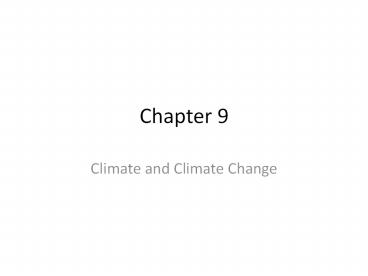Climate and Climate Change - PowerPoint PPT Presentation
1 / 29
Title:
Climate and Climate Change
Description:
Section 4: Climate Change The climate is gradually warming, and this is due to human activity. ... which can cause eye damage and skin cancer. – PowerPoint PPT presentation
Number of Views:698
Avg rating:3.0/5.0
Title: Climate and Climate Change
1
Chapter 9
- Climate and Climate Change
2
Section 1 What causes climate?
- Climate is the long-term, average conditions of
temperature, precipitation, winds, and clouds in
an area.
3
2 Factors of Climate
- 1. Temperature is influenced by latitude,
altitude, and the ocean.
4
2 Factors of Climate
- 2. Precipitation is influenced by winds and
mountains.
5
Winds and Clouds
- The windward side of a mountain is rainy and
snowy. - The leeward side of a mountain is dry.
- A monsoon is a seasonal period of heavy rain
6
The Seasons
- The seasons are caused by the tilt of the Earths
axis as Earth travels around the sun.
7
Vocabulary Illustration
- In your notebooks, for each word listed
- Write the word
- Write the definition
- Draw and color a small picture
Climate Microclimate Tropical Zone Polar Zone Temperate Zone
Marine Climate Continental Climate Ocean Current Windward Leeward
Monsoon El Nino La Nina Salinity Upwelling
8
Section 2 Currents and Climate
- Surface currents, which affect water to a depth
of several hundred meters, are driven mainly by
winds. - A surface current warms or cools the air above
it, influencing the climate of the land near the
coast
9
El Nino
- El Nino is a climate event that occurs every 2 to
7 years in the Pacific Ocean, during which winds
shift and push warm water toward South America.
10
La Nina
- La Nina is a climate event in the eastern Pacific
Ocean in which surface waters are colder than
normal.
11
Deep currents
- Deep currents move and mix water around the
world. - Salinity is the total amount of dissolved salts
in a water sample. - Upwelling is the movement of cold water upward
from the deep ocean.
12
Planet Earth Video
- Planet Earth Video Shallow Seas
13
Section 3 Climate Regions
- Scientists classify climate according to two
major factors temperature and precipitation. - Each special area of climate is called a biome.
14
8 Land Biomes
- 1. Rain forests have large amounts of rainfall
and a great diversity of species.
15
8 Land Biomes
- 2. Savannas are grasslands with few trees and a
distinct rainy season.
16
8 Land Biomes
- 3. Deserts are the driest biomes, with little
rainfall.
17
8 Land Biomes
- 4. San Diego is in the chaparral biome. It has
warm, dry summers, and cool, rainy winters.
18
8 Land Biomes
- 5. Grasslands have few trees and long cold
winters.
19
8 Land Biomes
- 6. Trees lose their leaves in a deciduous forest,
which has all 4 seasons.
20
8 Land Biomes
- 7. The coniferous forest or taiga has mountains
and evergreen trees, and is the biggest biome.
21
8 Land Biomes
- 8. The tundra is treeless, and the ground is
always frozen (permafrost).
22
Biome Map
- Color, answer the questions, and turn in the
Biome Map. - If you do not finish, it is homework.
- If you finish early, please do questions 1 and 2
on page 371 (PQA).
23
Section 4 Climate Change
- The climate is gradually warming, and this is due
to human activity. - This is called global warming or climate change.
24
Global Warming
- Gases in the atmosphere that trap heat are called
greenhouse gases.
25
Global Warming
- People have been producing more carbon dioxide
since the late 1800s by burning wood, coal, oil,
and gas. This warms the Earth.
26
Effects of Global Warming
- Because of global warming
- Droughts and floods occur
- Ocean levels rise
- Oceans become more acidic, fish die
- Storms become more frequent
- Winters are colder, summers are hotter
- Animals and plant go extinct
- Soil becomes less fertile
- Less drinking water is available
27
Ozone Depletion
- The ozone layer protects the Earth from harmful
UV rays. - Chlorofluorocarbons or CFCs cause holes in the
ozone, which can cause eye damage and skin cancer.
28
Cool Climate Graphs Page 372
- 1. Working in groups of 3, complete the procedure
steps 1-6 on page 372. - 2. In your notebooks, complete questions 1-6 on
page 373. PQA.
29
Review and Vocabulary
- 1. Complete the Review Sheet.
- 2. In your notebooks, for each word listed
- Write the word
- Write the definition
- Draw and color a small picture
Rain Forest Savanna Desert Steppe Chaparral
Humid Subtropical Subarctic Tundra Permafrost Ice Age
Global Warming Greenhouse Gas Ozone Hole Chlorofluorocarbon































